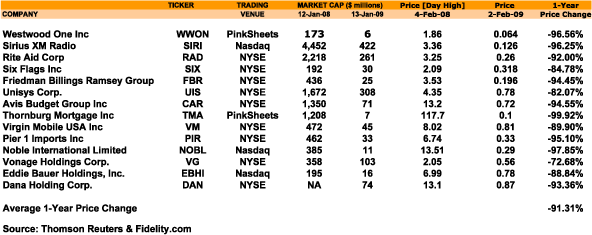CHEAP STOCKS: BREAKING THE BUCK
5 February 2009, Barron’s
A startling manifestation of this market meltdown is the vortex that’s been sucking the value out of stocks trading in the low single digits. According to a Thomson Reuters study prepared for Barron’s, the average price decline last year of the 637 NYSE- and Nasdaq-listed stocks that broke below $5 [but stayed above $1] was 61 percent. For the 176 stocks that traded below $1 any time during 2008, they declined a stunning 84 percent. Much larger-cap [and priced] stocks measured by the S&P 500, in contrast, fell only 38.5 percent.
Equally disturbing is not that long ago a number of the sub-$1 stocks were name-brand companies likely found in many equity portfolios [see table below]. They include retailers Rite Aid, Pier 1 Imports, and Eddie Bauer, radio broadcasters Westwood One and Sirius XM Radio, automotive parts giants Dana Holding and Noble International, to financials Friedman Billings Ramsey Group and Thornburg Mortgage.
These observations are more than an interesting aside to the crisis; they suggest higher than average risks associated when stocks break below certain levels. Ultra-low priced stocks are exposed to forces that can hamper recovery, including forced sales due to institutional restrictions on ownership, greater volatility, loss of margin usage, falling visibility, potential delisting off a major exchange to an OTC venue, and reduced research coverage.
According to Glenn Tyransky, head of financial compliance at NYSE Regulation, $1 is the minimum value the exchange requires a stock to maintain over any 30-day trading period. But his office issues warnings to companies when they break below $5, knowing how slippery the price slope becomes once it cracks that threshold.
With virtually all stocks suffering trailing 12-month double-digit losses, some investors may not differentiate between their big losers and their really big losers. They may be holding on to all equities with the same hope for recovery. Indeed, there are fund managers who expect some of their top-performing stocks going forward to come from this beaten down sub-$1 class, believing that market inefficiency and panic selling has disconnected prices from fundamentals. But for investors not carefully monitoring operating earnings, debt levels, and industry conditions, avoiding the “hope” trap and going bust may be impossible.
Peter Lynch believes for downtrodden stocks trading in the single digits, “the notion that if it gets back to $10, I’ll sell [virtually assures a] whole painful process [that] may take a decade, and all the while you’re tolerating an investment you don’t even like.” Unless an investor is confident enough in the company to buy more shares, Lynch thinks he ought to be selling immediately.
While he wouldn’t fault investors for tax-loss selling, Preston Athey, manager of the $3.6 billion T. Rowe Price Small-Cap Value Fund, looks at these new penny stocks as long-dated options. They could eventually rebound, but they run a well above-average chance of expiring, i.e., bankruptcy.
Athey has 14 stocks in his portfolio that are currently trading for under $1. They are a diversified group, crossing 10 industries including technology, food producers, retailing, media, and venture capital. While he acknowledges that a handful will likely go bankrupt, Athey expects these shares will collectively outperform both his total portfolio and the broad market over the next five years.
Contrary to what the Thomson data suggests, Athey thinks absolute price is almost immaterial to future performance. “Where cash flow and operational earnings are still positive and where there is more cash than debt on the books, stocks that are stuck trading below $1 could be there in part out of benign neglect,” he says.
An example Athey points to is Monterey Gourmet Foods [PSTA], a pasta manufacturer he has been in since 2001. Though he has taken a big paper hit with the stock trading at $0.79, he’s not panicked. “The company has the lead position at large retailers including Costco and Sam’s Club,” says Athey, “a book value of $3 a share, $0.20 of cash per share, has positive operational earnings and net cash flow, and carries no debt.” Over the next few years, he feels the stock could rebound to his $5 cost.
Bradford Evans, co-fund manager of the Heartland Value Plus fund, believes breaking the buck may not be the same harbinger for bankruptcy it once was. “Micro caps have been experiencing excessive price pressure from fund redemptions and forced liquidations,” says Evans, “which has contributed to extreme volatility and inefficient pricing.”
While he can’t speculate where the so-called “New Dollar” threshold may be, he believes a number of sub-$1 stocks will able to fix themselves without resorting to bankruptcy. He cites Digirad [DRAD], a manufacturer of nuclear thoracic cameras and imaging services with projected 2009 sales of $80 million, $28 million in cash, a book value of $2.47, but a market cap of $19 million and a stock price of just $1.09.
For the year the stock has traded down from its peak of $3.50 reached in early February 2008, having bottomed at $0.48 on December 4.
Evans, who owns the stock, believes it is poised for a turnaround this year because of a strong balance sheet, good technology, significant partnerships with leading medical schools, and a restructuring plan that will better manage growth while controlling costs.
Being a listed company doesn’t assure shareholders they can’t get wiped out as evidenced by Nortel Networks and Lehman Brothers. But the inability of a stock to sustain listing requirements, such as a minimum average stock price and market cap, can get it booted off the Big Board and Nasdaq. This can push a falling stock further behind the eight ball by reducing its visibility, liquidity, and pricing efficiency. But by then there’s often little to salvage.
Thornburg Mortgage, which ended 2007 with a market cap of $1.2 billion and a price of $92.40, was shunted from the NYSE to the Pink Sheets at the end of November 2008 when its stock closed the month at $0.52. By the end of the year, shares were trading at $0.16. As of early February, the stock was at $0.10.
According to NYSE’s Tyransky, 47 companies were delisted from the exchange last year for compliance violations, which included trading for an extended period of time below $1 and a market cap falling below $25 million. The number was three times the number of stocks delisted in 2007. And he sees a potential wave of delistings occurring in the second quarter of this year as the clock for compliance expires for several dozen firms.


 GIR's Investing in the New Europe
GIR's Investing in the New Europe




